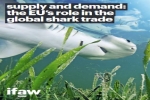Swimming kinematics of the Caribbean reef shark
Swimming kinematics of the Caribbean reef shark, Carcharhinus perezi Stephen M. Kajiura, John C. Loyer, Cassandra Ruddy, Marianne E. Porter ABSTRACT: The Caribbean reef shark, Carcharhinus perezi, is known to rest on the substrate, a behavior not documented in any of its congeners. We quantified swimming kinematics of C. perezi in the wild and found
Microbiome structure in large pelagic sharks with distinct feeding ecologies
Microbiome structure in large pelagic sharks with distinct feeding ecologies Pratte ZA, Perry C, Dove ADM, Hoopes LA, Ritchie KB, Hueter RE, Fischer C, Newton AL, Stewart FJ. ABSTRACT: Background: Sharks play essential roles in ocean food webs and human culture, but also face population declines worldwide due to human activity. The relationship between sharks
DNA Barcoding Identifies Endangered Sharks in Pet Food Sold in Singapore
DNA Barcoding Identifies Endangered Sharks in Pet Food Sold in Singapore Ian French, Benjamin J. Wainwright ABSTRACT: Shark populations have declined by more than 70% over the past 50 years. These declines have largely been attributed to increases in fishing efforts. Despite increased public awareness surrounding the conservation of sharks, three-quarters of all oceanic shark
Combined phylogeny and new classification of catsharks
Combined phylogeny and new classification of catsharks (Chondrichthyes: Elasmobranchii: Carcharhiniformes) Karla D A Soares, Kleber Mathubara ABSTRACT: This is the first study to combine morphological and molecular characters to infer the phylogenetic relationships among catsharks. All currently valid genera classified in the family Scyliorhinidae s.l. and representatives of other carcharhinoid families plus one lamnoid and
Five-Month Incubation of Viviparous Deep-Water Shark Embryos in Artificial Uterine Fluid
Five-Month Incubation of Viviparous Deep-Water Shark Embryos in Artificial Uterine Fluid Tomita Taketeru, Toda Minoru, Murakumo Kiyomi, Kaneko Atsushi, Yano Nagisa, Nakamura Masaru, Sato Keiichi ABSTRACT: In this study, we developed an extra-uterine life-support system (artificial uterus) for viviparous elasmobranchs. Using this system, we maintained two embryonic specimens of the slendertail lantern shark (Etmopterus molleri)
A mitochondrial genome assembly of the opal chimaera
A mitochondrial genome assembly of the opal chimaera, Chimaera opalescens Luchetti, Iglésias et Sellos 2011, using PacBio HiFi long reads Nair Vilas-Arrondo, André Gomes-dos-Santos, Montse Pérez, Francisco Baldó, Ana Veríssimo, Diana Catarino, André M. Machado, Esther Román-Marcote, Rafael Bañón, Elsa Froufe & L. Filipe C. Castro ABSTRACT: Chondrichthyans (sharks, rays and chimeras) are a fascinating
Emergent research and priorities for shark and ray conservation
Emergent research and priorities for shark and ray conservation Jorgensen SJ, Micheli F, White TD, Van Houtan KS and others ABSTRACT: Over the past 4 decades there has been a growing concern for the conservation status of elasmobranchs (sharks and rays). In 2002, the first elasmobranch species were added to Appendix II of the Convention
Reproductive biology of the Whitespotted eagle ray
Reproductive biology of the Whitespotted eagle ray Aetobatus narinari (Myliobatiformes) captured in the Coast of Paraíba and Pernambuco, Brazil Priscila R V Araújo, Maria C Oddone, Joaquim Evêncio-Neto, Rosangela Lessa ABSTRACT: The present study analysed aspects of reproductive biology based on macroscopic and microscopic structures of Whitespotted eagle ray Aetobatus narinari captured by artisanal fishing
Behavioural Changes and Physiological Adjustments of Elasmobranchs to Ocean Acidification
A Systematic Review of the Behavioural Changes and Physiological Adjustments of Elasmobranchs and Teleost’s to Ocean Acidification with a Focus on Sharks Ziv Zemah-Shamir, Shiri Zemah-Shamir, Aviad Scheinin, Dan Tchernov, Teddy Lazebnik, Gideon Gal ABSTRACT: In recent years, much attention has been focused on the impact of climate change, particularly via ocean acidification (OA), on
IFAW Report: EU’s role in the global shark trade
Shea, S., Slee, B., O’Toole, M. (2022)Supplyand Demand: the EU’s role in the global shark trade.Stichting IFAW (International Fund for Animal Welfare),The Hague, The Netherlands. 36pp PDF-DOWNLOAD
Cryptic Vertical Movement Patterns of White Sharks Along the Californian Coast
Multi-Decadal High-Resolution Data Reveal the Cryptic Vertical Movement Patterns of a Large Marine Predator Along the Californian Coast Samantha Andrzejaczek, Taylor K. Chapple, Salvador J. Jorgensen, Scot D. Anderson, Michael Castleton, Paul E. Kanive, Timothy D. White, Barbara A. Block ABSTRACT: Over the last two decades, satellite tagging of adult and sub-adult white sharks Carcharodon
Population structure and genetic connectivity of the scalloped hammerhead shark across nursery grounds from the Eastern Tropical Pacific
Population structure and genetic connectivity of the scalloped hammerhead shark (Sphyrna lewini) across nursery grounds from the Eastern Tropical Pacific: implications for management and conservation Mariana Elizondo-Sancho, Yehudi Rodríguez-Arriatti, Federico J. Albertazzi, Adrián Bonilla-Salazar, Daniel Arauz, Randall Arauz, Elisa Areano, Cristopher G. Avalos-Castillo, Óscar Brenes, Elpis J. Chávez, Arturo Dominici-Arosemena, Mario Espinoza, Maike Heidemeyer, Rafael
Spatial Distribution, Temporal Changes, and Knowledge Gaps in Basking Shark Sightings in the California Current Ecosystem
Spatial Distribution, Temporal Changes, and Knowledge Gaps in Basking Shark (Cetorhinus maximus) Sightings in the California Current Ecosystem Alexandra G. McInturf, Barbara Muhling, Joseph J. Bizzarro, Nann A. Fangue, David A. Ebert, Damien Caillaud, Heidi Dewar ABSTRACT: Among the largest fish species, the basking shark (Cetorhinus maximus) is found circumglobally in temperate and tropical waters.
Strengthening Angel Shark Conservation in the Northeastern Mediterranean Sea
Strengthening Angel Shark Conservation in the Northeastern Mediterranean Sea Giovos, Ioannis, Dimitra Katsada, Roxani N.A. Spyridopoulou, Dimitrios Poursanidis, Aggeliki Doxa, Stelios Katsanevakis, Periklis Kleitou, Vasiliki Oikonomou, Vasileios Minasidis, Ayaka A. Ozturk, Dimitra Petza, Maria Sini, Cahide C. Yigin, Eva K.M. Meyers, Joanna Barker, David Jiménez-Alvarado, and Ali R. Hood ABSTRACT: Angel sharks are among the
Global assessment of shark strandings
Global assessment of shark strandings Natascha Wosnick, Renata D. Leite, Eloísa P. Giareta, Danny Morick, Michael Musyl ABSTRACT: Marine wildlife stranding is a global phenomenon, and for some taxonomic groups, these events are well monitored and documented. Although sharks are among the most threatened vertebrates, strandings have historically been neglected, with little information on this




